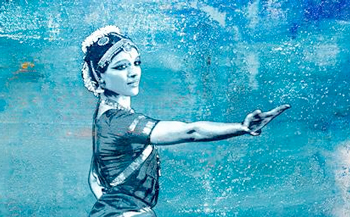by Jane Berkner

A symmetrical pairing of five dancers and five musicians performed this marriage of two cultures — the musicians positioned on a raised platform on stage right, the dancers performing as an ensemble, as soloists, or in duos and trios in the middle of the stage.
A single work, Song of the Jasmine, encompassed the entire evening. Program notes described the works creative process: the music and dance elements were born simultaneously, “in a constant artistic dialogue that spanned more than a year.” The result was a collaborative creation with seamless fluidity, a constant interplay of shared rhythms passed between musicians and dancers.
The dancers were dressed in colorful costumes with beaded headdress. Their palms, feet and toes painted with red henna. Thick bracelets of small sleigh bells strapped around their ankles, produced a percussive sound as the dancers slapped their bare feet on the stage. Multiple layers of rhythm were formed between the hypnotic swaying of their bodies and the cadenced striking of their feet.
The dancers’ gestures were clearly symbolic, depicting the story of a young Indian girl from a poem by Ravi Shankar. It would have been helpful to have heard the group talk about the art form. Those of us who are unfamiliar with Indian dance might have grasped the subtleties better had they been explained.
Music and dance were given equal billing and equal attention in this production. At one point, a long stretch of time was devoted to music performed without the dancers. It was here that the virtuosic saxophone playing of Mahanthappa came to the forefront. The constant drone note of the Indian music often inhibited the harmonic possibilities, and he took advantage of its absence during his long solo interlude, employing more jazz-like harmonies and using extended techniques on his instrument.
The drone was passed among the instruments throughout the evening, and each musician contributed improvisational material to the composition. It was impossible to discern where the formal structure of the music began or ended. The written material itself sounded improvised even when the musicians locked in together on their many well-played unisons.
Each musician brought something unique to the sound of the ensemble. Raman Kalyan played his bamboo flute with equal parts of sweetness and intensity. Guitarist Rez Abbasi brought an almost rock-like element to this paring of jazz and Indian music. Anjna Swaminathan’s violin sound was woven constantly into the fabric of the piece. She played from an unusual seated position that produced the nasal sounds conducive to Carnatic Indian music.
The real driving force of this instrumental group was the complex rhythmic output of percussionist Rajna Swaminathan playing a mridangam, an instrument similar to the tabla, her hands were astonishingly poetic. Her long and lithe fingers shaped and pulled the rhythm from her Indian drum. Meanwhile the dancers’ feet moved with an energetic flexibility that was mirrored in her hands, percussionist and feet often locked in a breathtaking sameness of rhythm.
Published on ClevelandClassical.com February 17, 2015.
Click here for a printable copy of this article


